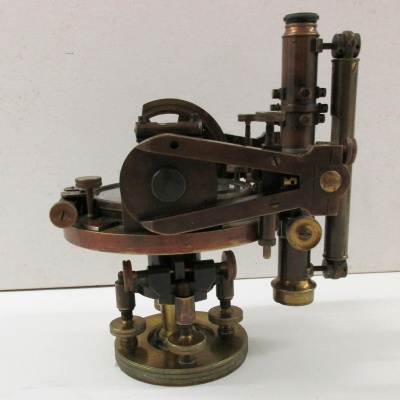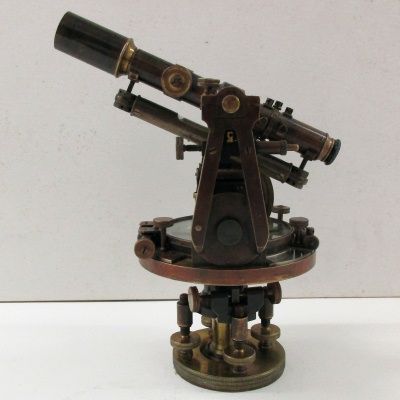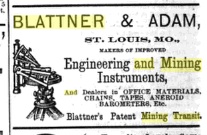|
CECIL E. HANSON COLLECTION |
|
|
AMERICAN TRANSITS |
|
|
Blattner & Adams -
St. Louis, MO, ca.1885 |
|
 |
 |
 |
 |
|
Serial Number: 5689 |
 |
|
Excerpted from “Makers of Surveying Instruments of America since 1700” by Charles Smart, 1962, Vol 1, pp. 9-11 JACOB BLATTNER (1812 – 1888) St. Louis, Missouri Jacob Blattner came to St. Louis in the fall of 1839, by way of the port of New Orleans from Berne, Switzerland. Probably he had made instruments in Switzerland before coming to America, because besides its own family, he brought with him his foreman and the foreman’s family. Jacob Blattner was born in Berne, Switzerland, May 21, 1812 and uted in St. Louis November 15, 1888. He is first listed in the 1840-41 St. Louis directory as a mathematical instrument maker. He continued in business until about 1872 when failing eyesight compelled his retirement. The business was carried on by his son Henry and his son-in-law Frank Adam, under the firm name of Blattner & Adam. The Missouri Historical Society in St. Louis has a silver cup willed by one of Jacob Blattner’s Granddaughters on which is inscribed “Mechanic’s Fair-St. Louis 1841, awarded to J. Blattner”; a water color of his birth place in Berne; and 2 Surveyor’s Compasses inscribed, “J. Blattner, St. Louis”. They are 16" overall, with a 6" needle. Gurley repaired a Blattner transit in 1875; another in 1880 and a
level in 1886. BLATTNER & ADAM (1872 - 1891) St. Louis, Missouri When Jacob Blattner retired in 1872, Henry Blattner, his son, who
had been working with his father, took over the business, together with
his brother-in-law, Frank Adam. The 1874 St. Louis directory lists them
as “Blattner & Adam, (Henry Blattner & Frank Adam) mathematical and
optical instrument makers.” The instrument business was In 1891 the business was split into three parts, because the Blattner & Adam store was taken over by a real estate firm to build the Rialto building. Henry Blattner took the optical business to a store on Broadway. After several years in his Broadway store, Henry Blattner sold his optical business, and he went into special photographying. He was one of the early developers of the so-called “dry plate” for photography. Adolph Wissler, who had been a workman and foreman for Blattner & Adam took over the instrument business, which he continued until his death in 1926. Frank Adam took over the electrical department which became the Frank Adam Electrical Company, which is a continuing business in 1962. Henry Blattner was born in St. Louis March 6, 1848, and died there on November 10, 1922. Frank Adam was bom in Freiburg, Alsace-Loraine, February 2, 1838 and died in St. Louis September 13, 1922. He married Jacob Blattner’s daughter, Louise, who was born on the high seas coming from Europe to America on September 29, 1839. In 1890 Gurley sold Blattner & Adams two Architech levels. Gurley repaired a Blattner & Adams transit #10, which was owned by the Southern Pacific Railroad in 1892. **************************************** For additional information on Blattner & Adams see "St. Louis Instrument Makers" by Hugh A. Parsons and Richard L. Elgin at: http://www.surveyhistory.org/st__louis_instrument_makers1.htm
**************************************** From "The Evolution of the Transit" by Dale Beeks (http://www.surveyhistory.org/evolution_of_the_transit1.htm):
"Another series of rare adaptations of the transit evolved for use in
mines, since mine surveying presented special problems. The
conventional transit was unable to give readings of extreme vertical
angles up and down steep shafts and slopes, because the line-of-sight
would be obscured by the horizontal plate. This problem led to some
pretty radical changes, all of them designed so that the line-of-sight
would bypass the horizontal plate and allow for vertical sightings.
Some of the more scarce designs include the inclined standard transit,
Blattner's hinge-standard model,
and Buff and Berger's duplex telescope-bearing transit designed in
1889. Both instruments were fit with telescopic standards that extended
beyond the vertical plane of the horizontal circle. One form of mining
instrument that gained popularity, probably due to its ease of ability
to convert, was the auxiliary, or double-telescope mining transit. This
was basically a standard from of transit with a detachable second
telescope and counter weight. The points of attachment were at the ends
of the telescope axis, outside the standards. Other designs included
attachment of the auxiliary telescope to the existing telescope as well
as to the outside of the standards."
|
|
